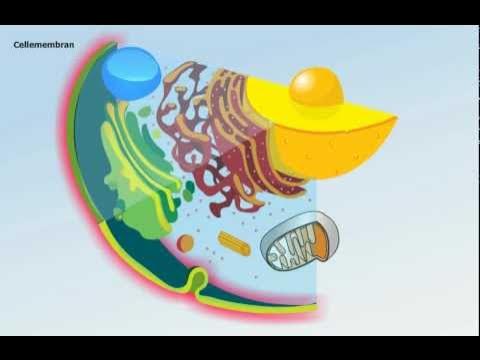MITOKONDRIA, VAKUOLA DAN LISOSOM
Summary
TLDRIn this educational video, Davin David discusses the structure and function of three important cell organelles: mitochondria, vacuoles, and lysosomes. The video explains mitochondria's role in energy production through cellular respiration, vacuoles' function in storing essential substances, and lysosomes' involvement in intracellular digestion. Using visuals and simple explanations, the video breaks down complex biology concepts for high school students, aiming to support their studies in cell biology. The host encourages viewers to like, share, comment, and subscribe for more educational content.
Takeaways
- 😀 Mitochondria are cylindrical, double-membraned organelles responsible for energy production in the cell through cellular respiration.
- 😀 The inner membrane of mitochondria has cristae that increase surface area for ATP synthesis and oxidation of food substances.
- 😀 Mitochondria play a key role in cellular energy production, making them known as 'The Powerhouse of the Cell.'
- 😀 Vacuoles are large, membrane-bound organelles that store water, food, pigments, essential oils, and waste products in plant cells.
- 😀 The outer membrane of vacuoles is called the tonoplast, which helps protect and enclose the vacuole's contents.
- 😀 In protozoa, vacuoles vary in size and function, with contractile vacuoles helping with osmoregulation and food vacuoles aiding digestion.
- 😀 The vacuoles in plant cells are much larger than those in protozoa, with the main function being storage.
- 😀 Lysosomes are small, round organelles containing hydrolytic enzymes that help with intracellular digestion and the breakdown of foreign substances.
- 😀 Lysosomes are involved in endocytosis, autophagy, phagocytosis, and autolysis, playing key roles in cellular cleanup.
- 😀 The main difference between contractile and food vacuoles in protozoa is that contractile vacuoles help regulate fluid pressure, while food vacuoles aid in digestion.
- 😀 The video encourages students to keep supporting the channel by liking, sharing, commenting, and subscribing for more biology content.
Q & A
What are the main topics discussed in the video?
-The video discusses cell organelles, specifically mitochondria, vacuoles, and lysosomes.
What mnemonic did the speaker mention to help remember the cell organelles?
-The speaker mentioned a mnemonic: MPL B Squared ER Squared NSP, which refers to Mitochondria, Vacuoles, Lysosomes, Golgi Bodies, Microbodies, Ribosomes, Endoplasmic Reticulum, Nucleus, Centrosomes, and Plastids.
What is the main function of the mitochondria?
-The main function of the mitochondria is to provide energy for the cell through cellular respiration, specifically by synthesizing ATP.
What is the structure of mitochondria?
-Mitochondria are cylindrical or elongated, with two membranes: an outer membrane for protection and an inner membrane with cristae that increases the surface area for cellular functions.
What is the function of the cristae in mitochondria?
-The cristae increase the surface area inside the mitochondria, which enhances its ability to generate energy.
What is the role of vacuoles in plant cells?
-Vacuoles in plant cells serve various functions, but their main purpose is to store food reserves, pigments, essential oils, metabolic waste, and water.
What is a tonoplast, and what is its function?
-The tonoplast is the outer membrane of a vacuole in plant cells. Its function is to protect the vacuole and regulate the substances it contains.
What is the difference between contractile and food vacuoles in protozoa?
-Contractile vacuoles regulate fluid pressure and excretion, while food vacuoles are involved in intracellular digestion and the transport of food substances.
What is the structure of a lysosome?
-A lysosome is small and round, with a lipid membrane containing many hydrolytic enzymes that play a role in digestion within the cell.
What are the main functions of lysosomes?
-Lysosomes are involved in intracellular digestion, endocytosis, autophagy, phagocytosis, exocytosis, and autolysis. They help break down food substances and foreign materials.
Outlines

Cette section est réservée aux utilisateurs payants. Améliorez votre compte pour accéder à cette section.
Améliorer maintenantMindmap

Cette section est réservée aux utilisateurs payants. Améliorez votre compte pour accéder à cette section.
Améliorer maintenantKeywords

Cette section est réservée aux utilisateurs payants. Améliorez votre compte pour accéder à cette section.
Améliorer maintenantHighlights

Cette section est réservée aux utilisateurs payants. Améliorez votre compte pour accéder à cette section.
Améliorer maintenantTranscripts

Cette section est réservée aux utilisateurs payants. Améliorez votre compte pour accéder à cette section.
Améliorer maintenantVoir Plus de Vidéos Connexes

Eukaryote celler

ORGANELAS CITOPLASMÁTICAS - Resumo | Biologia com Samuel Cunha

Cell Organelles and Structures - A Tour of the Cell

The Fundamental Unit of Life in 25 Minutes🔥| Class 9th | Rapid Revision | Prashant Kirad

Organelles: Structure and Function (AP BIOLOGY)

2.1 Cell Structure: Subcellular Components - AP Biology
5.0 / 5 (0 votes)
